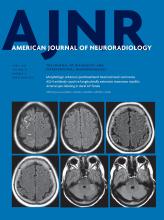Research ArticleADULT BRAIN
HARMless: Transient Cortical and Sulcal Hyperintensity on Gadolinium-Enhanced FLAIR after Elective Endovascular Coiling of Intracranial Aneurysms
S. Suthiphosuwan, C.C.-T. Hsu and A. Bharatha
American Journal of Neuroradiology April 2018, 39 (4) 720-726; DOI: https://doi.org/10.3174/ajnr.A5561
S. Suthiphosuwan
aFrom the Division of Diagnostic and Interventional Neuroradiology, Department of Medical Imaging (S.S., C.C.-T.H., A.B.)
C.C.-T. Hsu
aFrom the Division of Diagnostic and Interventional Neuroradiology, Department of Medical Imaging (S.S., C.C.-T.H., A.B.)
A. Bharatha
aFrom the Division of Diagnostic and Interventional Neuroradiology, Department of Medical Imaging (S.S., C.C.-T.H., A.B.)
bDivision of Neurosurgery, Department of Surgery (A.B.), St. Michael's Hospital, University of Toronto, Toronto, Ontario, Canada.

References
- 1.↵
- Wilkinson ID,
- Griffiths PD,
- Hoggard N, et al
- 2.↵
- 3.↵
- Ogami R,
- Nakahara T,
- Hamasaki O, et al
- 4.↵
- 5.↵
- 6.↵
- Kim EY,
- Kim SS,
- Na DG, et al
- 7.↵
- 8.↵
- 9.↵
- Taoka T,
- Yuh WT,
- White ML, et al
- 10.↵
- 11.↵
- Iancu-Gontard D,
- Oppenheim C,
- Touze E, et al
- 12.↵
- Morris JM,
- Miller GM
- 13.↵
- Mamourian AC,
- Hoopes PJ,
- Lewis LD
- 14.↵
- Bozzao A,
- Floris R,
- Fasoli F, et al
- 15.↵
- 16.↵
- 17.↵
- Renú A,
- Laredo C,
- Lopez-Rueda A, et al
- 18.↵
- Latour LL,
- Kang DW,
- Ezzeddine MA, et al
- 19.↵
- Warach S,
- Latour LL
- 20.↵
- 21.↵
- 22.↵
- Köhrmann M,
- Struffert T,
- Frenzel T, et al
- 23.↵
- 24.↵
- Merino JG,
- Latour LL,
- Tso A, et al
- 25.↵
- 26.↵
- Freeze WM,
- Schnerr RS,
- Palm WM, et al
- 27.↵
- Kang DH,
- Kim BM,
- Kim DJ, et al
- 28.↵
- Kim B,
- Kim K,
- Jeon P, et al
- 29.↵
- Brisman JL,
- Jilani M,
- McKinney JS
- 30.↵
- Ozturk A,
- Saatci I,
- Pamuk AG, et al
- 31.↵
- 32.↵
- 33.↵
- 34.↵
- 35.↵
In this issue
American Journal of Neuroradiology
Vol. 39, Issue 4
1 Apr 2018
Advertisement
S. Suthiphosuwan, C.C.-T. Hsu, A. Bharatha
HARMless: Transient Cortical and Sulcal Hyperintensity on Gadolinium-Enhanced FLAIR after Elective Endovascular Coiling of Intracranial Aneurysms
American Journal of Neuroradiology Apr 2018, 39 (4) 720-726; DOI: 10.3174/ajnr.A5561
0 Responses
Jump to section
Related Articles
- No related articles found.
Cited By...
- No citing articles found.
This article has not yet been cited by articles in journals that are participating in Crossref Cited-by Linking.
More in this TOC Section
ADULT BRAIN
Similar Articles
Advertisement











